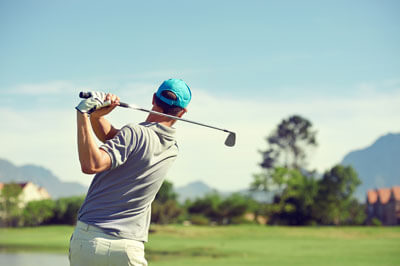Tennis Elbow & Golfer’s Elbow
Typical History
Pain on the inside (golfer’s elbow) or outside (tennis) of the elbow.
Anatomy of Tennis and Golfer’s Elbow and Where the Names Came From
 The muscles and tendons that become irritated in tennis elbow are those that attach to the outside of the elbow. These muscles function to bend the wrist backwards (extension). During the backhand swing in tennis these muscles pull on the elbow to prevent the wrist from buckling forward during impact with the ball. Repeatedly performing backhand swings causes a repetitive stress injury that causes pain on the outside of the elbow.
The muscles and tendons that become irritated in tennis elbow are those that attach to the outside of the elbow. These muscles function to bend the wrist backwards (extension). During the backhand swing in tennis these muscles pull on the elbow to prevent the wrist from buckling forward during impact with the ball. Repeatedly performing backhand swings causes a repetitive stress injury that causes pain on the outside of the elbow.
The muscles and tendons that become inflamed in golfer’s elbow are those that attach to the inside of the elbow. These muscles operate to bend the wrist forwards (flexion). When the golf club impacts the ground (as occurs when taking a divot) the trailing elbow (ex. the right elbow in a right handed swing) bends inwards (in the same direction the ball will travel). This puts significant stress on the tendons attaching to the inside of the elbow and may result in golfer’s elbow.
Symptoms of Tennis and Golfer’s Elbow
Tennis elbow results in pain at or near the boney bump (lateral epicondyle) on the outside of the elbow. Golfer’s elbow causes pain at or near the boney bump (medial epicondyle) on the inside of the elbow.
Factors That May Contribute to Tennis or Golfer’s Elbow
Although tennis and golf are the sports from which the conditions derived their names, many other activities that involve repeated use of the forearm muscles can cause the same problems.
Your doctor will perform a series of tests that are designed to test for each condition. If pain occurs on the inside of the elbow while holding the wrist bent forwards (flexed) against resistance or bending the wrist backwards (extending) to stretch the muscles involved, the golfer’s elbow is a likely diagnosis. If pain occurs on the outside of the elbow while holding the wrist bent backwards (extended) against resistance or bending the wrist forwards (flexing) to stretch the muscles involved, tennis elbow is probable.
The Cummings Chiropractic Family Wellness clinic has very effective techniques for treating both conditions. Active Release Techniques is an option to alleviate stress on the tendons. Therapy machines unique to our clinic called Diapulse effectively reduce inflammation that occurs in both conditions. The patient is also instructed in-home care techniques to relieve tension on the involved muscles and tendons and is guided in identifying and modifying the activity that is causing the problem.
Good for return to most activities within 3 weeks for the vast majority of patients. Very advanced cases may require up to 8 weeks. Without treatment, the condition may progressively worsen.
We Can Help
Discover for yourself how chiropractic may help you. Contact us today to schedule an appointment!
CONTACT US »

